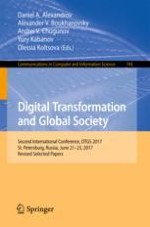2017 | Buch
Digital Transformation and Global Society
Second International Conference, DTGS 2017, St. Petersburg, Russia, June 21–23, 2017, Revised Selected Papers
herausgegeben von: Daniel A. Alexandrov, Alexander V. Boukhanovsky, Andrei V. Chugunov, Yury Kabanov, Olessia Koltsova
Verlag: Springer International Publishing
Buchreihe : Communications in Computer and Information Science
